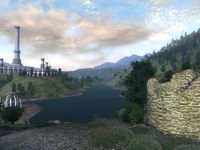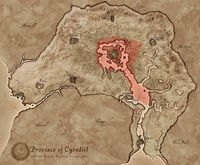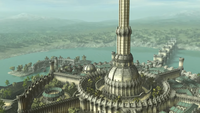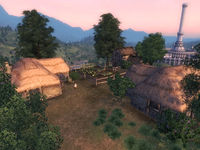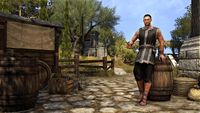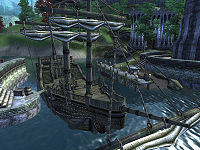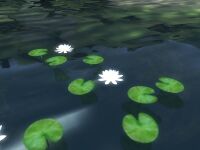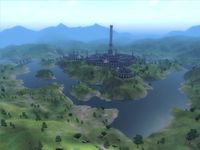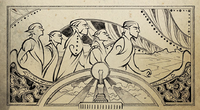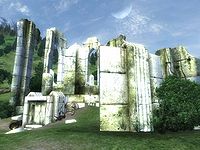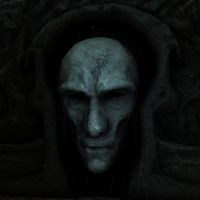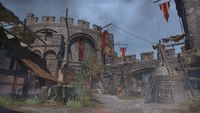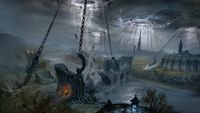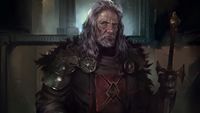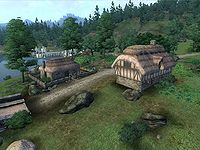User:Vincentius1/Sandbox 3
| Heartlands | |
|---|---|
| Type | Region |
| Continent | Tamriel |
| Province | Cyrodiil |
| Subregions | City Isle |
| Demonym(s) | Heartlander |
| Appears in | Oblivion, ESO |
The Heartlands (also known as the Valley Heartland)[1] are the central lowlands of Cyrodiil, a grassland region surrounding the expanse of Lake Rumare, as well as the Upper Niben and Niben Bay.[2][3] At its center is the Imperial City, the largest settlement in the province and the seat of Empires, from the original Ayleid Empire[4] to the Cyrodilic Empires of Man.[5]
The Heartlands and the Imperial City are a part of the greater Nibenay region,[6] more specifically the Nibenay Valley that encapsulates the rest of the Niben River and reaches as far south as Blackwood.[3][7] The Heartlands are geographically bordered by the Great Forest from the north, south, and west, the Nibenay Basin to the east, and the central Nibenay Valley around Bravil.[7]
Society and Geography[edit]
Demographics[edit]
The local Imperials are known as Heartlanders, an apt name for this sub-section of Nibenese that live in and around the Imperial City. They are also called Imperial Heartlanders[8] and Nibenean Heartlanders.[9] As is across the Nibenay, there is a hierarchical distinction to be made between the people of the Imperial City and the village-folk outside of it.[3] The villagers live in communities such as Aleswell, Pell's Gate, and Weye. Other lower-class citizens also live in the Waterfront District of the Imperial City, which is outside the outer walls, on Lake Rumare.[2]
The higher class of the greater Nibenay comprises the merchant-nobility, as well as the temple priests, cult leaders, and ancient battlemage aristocracy. A notable Heartlander family is the Carvain family who ruled County Bruma in the late Third Era.[9][10] Both classes take customs from the Akaviri,[3] namely the Tsaesci,[11][12] that were once prevalent in the Imperial City under the Second Empire.[3] Colovians from the west can also be found in the Heartland, however, most of them come from the Imperial Legion military,[13]:158 who are headquartered in the Imperial City Prison.[14]
The Imperial City, as the epicenter of the Empire, is cosmopolitan.[5][15] Upon his ascension to the throne, Reman I incorporated aspects of the Nibenay, Colovia, High Rock, and the recently defeated Akaviri to turn the Imperial City and his Empire of Man into a worldly center of civilization.[5] This even extended to the Third Empire, which came much later. In its early years, Redguards were seldom seen, at least compared to the Bretons, Dunmer, and Nords. In a biographical note written in the Notes for Redguard History, the famous author of Redguard history and verse, Destri Melarg had to adopt his surname to fit in with these other cultures.[16] In at least the first half of the Second Era, there was also a small, yet notable community of Bosmer in the Waterfront District.[17]
Before it was taken over by the Imperials, the White-Gold Tower was the seat of the Ayleid Empire, a vast nation across modern-day Cyrodiil that comprised of the eponymous Ayleids, also known as the Heartland High Elves.[18][19] The enchanters of this period were considered some of the most clever and prodigal in the craft.[20] With the White-Gold Tower's establishment, trade flourished in central Cyrodiil and especially south in the Niben Bay, where it became one of the Ayleid Empire's most active and secure regions.[21][22] Up north in the Heartlands, several city-states sprung up around it, whether it was around Lake Rumare like Fanacasecul, or further out like Belda more inland and Culotte on the Upper Niben.[2]
Ayleid Lore[23]
Some of them hold dark, ancient secrets and history, like Sercen's "gut-gardens"[18] and Nagastani, which supposedly held some kind of evil power that has left the land around it dead.[24] Perhaps the most infamous city-state was Abagarlas, a former city of mercenaries and center of worship for Molag Bal. Its ancient history is tied to a rival city of Meridia known as Delodiil, which was also located in the Heartlands. But while Abagarlas' ruins remain underneath City Isle, Delodiil's location and ruins are completely lost to time.[25]
Modern translations of what remains of the Unhendra Nibenu, a Merethic Era epic of Topal the Pilot's explorations indicate that before the Ayleids lived in the Heartlands, there was a race of Bird beastfolk that has since gone extinct. The fourth fragment of the Unhendra Nibenu remains as one of the only sources of their existence. The Third Era scholar who translated it, Florin Jaliil believed that their extinction came from an encounter with the "cat demons" mentioned early in the text.[21]
Culture and Industry[edit]
Culturally, this region is distinguished from other places like County Bruma as the Heartland Empire[26] and is considered by many, along with the Nibenay Valley as the agricultural breadbasket of Cyrodiil.[27] Many of its locals outside of the Imperial City take up farming to sustain themselves and feed the province at large,[28] Some of them, like the people of Weye come to the city's Market District to sell their wares.[13]:23 Textiles and rice were primary exports. With the latter in particular, thousands of workers tended to the flooded fields.[3]
- Farming/Fishing
- Trade/Merchant society[3]/Weye trades in IC
Surrounding Lake Rumare is the Red Ring Road, a major thoroughfare that connects the Imperial City and the Heartlands to the rest of Tamriel.[7][29] Going clockwise, from the north it branches with Skyrim via the Silver Road,[7][29][30] from the northeast with Morrowind via the Blue Road,[7][29][31] from the southeast with Black Marsh with the Yellow Road, from the south with the Topal Bay region and Elsweyr with the Green Road,[7][29][32] from the southwest with Colovia and Valenwood through the Gold Road,[7][29] and from the northwest with Hammerfell through the Black Road.[7][29][33]
With Lake Rumare and access to the Nibenay's river systems, the Heartlanders, or the Nibenese also use ferries and gondolas to navigate the region. Much of Cyrodiil is a river-based society and trade regularly occurs throughout it.[3] Ships throughout the Heartlands are mostly small riverboats that travel in and around the lake, through the watery avenues of the Imperial City, and even outlying territories and friendly inland ports.[3] Large vessels that come in from the Topal Bay must switch once they reach Leyawiin,[34] though bigger boats are known to dock on the Waterfront[35] and sail the Niben Bay.[36]
Ever since the Second Empire, many of the local Heartlanders have taken up old Akaviri traditions and customs. For example, villagers build paper hako-skiffs with dragon-motifs to wing their dead down the rivers.[3] Even with their exodus at the start of the Interregnum,[37] by the late Second Era, Akaviri ancestry was highly valued and their Imperial descendants were distinguished, with certain noble families bearing facial features tracing back to them. Akaviri Surnames were also rare and prized among the upper class.[3]
There is a heavy military presence in the Heartlands as the Imperial Legion is based in the Imperial City Prison,[14] on the northeast side of City Isle.[2] Ruined and abandoned keeps from the Interregnum, like Fort Homestead or Fort Urasek litter the shoreline.[3][2] Some of them in their heyday were large impressive fortresses, connected to the rest of central Cyrodiil through the Transitus Network, an obscure form of magical transportation that was in heavy use in the Three Banners War. Six keeps that surrounded the Imperial City were vital for absolute control of the greater region. Four of these keeps, Alessia, Aleswell, Blue Road and Chalman are located in the Heartlands.[40]
The forts that are built further south in the Niben Bay were part of the early Second Empire's effort to expand south. Fort Grief, built on an island in the middle of the bay, was designed to protect the eastern shoreline from raiders. But the Empire's rapid expansion effectively made them obsolete as not even the most aggressive Argonian fighters would attack the Heartlands.[41] When the Legion used these forts, they used a special alcoholic beverage known as Shadowbanish Wine to wield night eye and actively monitor the area on cold nights. Though this wine has long gone extinct, fully intact bottles are said to still be hidden in these ruins.[42]
Previously an old Ayleid district, the Arcane University on the southeast side of City Isle was for the longest time, the headquarters of the Mages Guild[43] but throughout its history, it has been the center of magical research and study.[44] Wellspring Grove, a forest on the eponymous island in Lake Rumare use to be tended by mages from the guild. They specifically used wood from the grove to craft their staves and later enchant them in the university's chironasium.[45]
For a time, the Mages Guild was banished from the Imperial City, they were replaced by the Fellowship of Anchorites, who are more commonly known as the Order of the Black Worm, or the Worm Cult.[46] They were placed there by remnants of the Empire of Cyrodiil, at the time under Empress-Regent Clivia Tharn, a pocket ruler to the King of Worms, Mannimarco.
- Imperial Sewers
Ecosystem[edit]
The Heartlands are a temperate grassland[3][28]
The Heartlands, as well as the Nibenay Valley, are considered the agricultural breadbaskets of Cyrodiil.[27]
- River mouth tainted by tinmi soil[3]
- Fertile farmland[28]/Flooding[3]
- City Isle/Eight Islands[21]
- Sacred Lotus/Water Hyacinth/Nirnroot/Fly Amanita/Lavender/Morning Glory
- Brindle Badger/Heartland Butcher's Dog/River Crab/Shezarr's Chicken
- Rumare Slaughterfish/Lake Fish (Runmare Bream/Rainbow Fish/Yellow Perch)/Foul Fish (Sewer Eel/Pufferfish/Quillfish)
Upon his rise in the late Second Era, Tiber Septim offered protection for any remaining dragons. Records from that time talk of dragons encircling the towers of the Imperial City and "river dragons" around the mouth of the Niben, where their scales rust in the water.[3] Some of them like Nafaalilargus fought for the Empire during the Tiber War[47] but despite the promise of sanctuary, they were still hunted and slain.[48]
The Subtropical Heartlands[edit]
History[edit]
The Pre-Imperial Heartlands[edit]
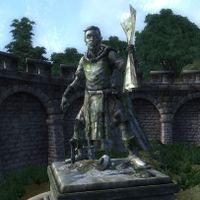
It is generally understood that before man and mer lived on Tamriel, the beastfolk were the sole inhabitants of the continent.[50] In the Heartlands, it was occupied by an ancient race of birdmen whose legacy remains in oral histories and the fragmented ballad of Topal the Pilot, the Unhendra Nibenu.[5][21] A translation of these fragments and notes provided by Florin Jaliil, gives us a look into Topal's journey in the Middle Merethic Era.[21]
As the Niben sailed along the eastern continental seaboard, trying to find their way back to Firsthold, they come across the Topal Bay and at the behest of his crew, traveled north through the Niben River. En route, they witnessed "cat demons" and in eleven days time, they reached Lake Rumare and the Eight Islands in its center. Topal became enchanted by the beauty of the islands and the birdfolk that lived there. He taught them how to read and write, and in gratitude, they named him their lord and offered him the islands as a gift,[21] though some people suggest it was a transaction.[51] Topal made a promise that he would return one day,[21] and while the story of his return remains a mystery, the elves of the distant Summerset Isles did eventually return.[4]
The Heartlands, at that time, was purportedly a tribute land to the High King of Alinor. In time, the original Ayleids came to populate the Heartlands.
Early History[edit]
The Heartlands in the Second Empire[edit]
As the Remanada goes, a shepherdess named Sed-Yenna came from Sancre Tor and carried a small child named Reman to the White-Gold Tower and placed him on the Ruby Throne. He then spoke as an adult, "I AM CYRODIIL COME".[57] In the late First Era, the First Akaviri Invasion took place and advanced west toward Cyrodiil. Reman united the Nibenay Valley's army and the Colovian West, creating the Army of Reman to combat the threat. In the end, Reman defeated the Akaviri and with their help, created the Second Empire of Man.[3][59] Through the combination of his allies and the Breton customs of High Rock, he turned Cyrodiil and the Imperial City into a cosmopolitan metropolis.[5]
Though people nowadays believe the neighboring kingdoms were quick to recognize his reign, this was not entirely the case as the borders were not reliably secure. Many Imperial forts and strongholds were built to fight raiders and bandits,[60] and protect the Heartlands and Niben Bay.[41] The Trans-Niben region, where warlike clans of Anequina stalked northern Blackwood and the nearby unconquered Black Marsh were notable threats in the south.[60] Fort Grief was built on the mouth of the Silverfish River to protect the eastern Niben Bay but with how quick Reman's expansion was, it lost purpose and was largely abandoned in 1E 2900.[41]
The Akaviri were given amnesty by Emperor Reman and integrated themselves into Tamrielic society, predominantly living in the Imperial City.[3]
In the late years of the Four-Score War, Prince Juilek and the Imperial Army were stationed in Bethal Gray, a village in the Heartlands near the forest before they traveled east for the Siege of Ald Marak in Morrowind.[62]
The Heartlands in the Interregnum[edit]
The Heartlands in the Third Empire[edit]
Though Cyrodiil experienced relative peace throughout the early Third Era,[66] the Heartlands and the Imperial City have had moments of weakness.[5] The first year of the War of the Red Diamond was one such example. As conflict arose in northern Tamriel, Empress Kintyra II led an army to the Iliac Bay, leaving the Imperial City short on defenses. With the Elder Council completely occupied and the rest of the Imperial Army sent off as well, Prince Uriel Mantiarco of Solitude invaded the ill-defended city and proclaimed himself Emperor Uriel Septim III, while his cousin Kintyra II was imprisoned.[67][68] Years later in 3E 127, King Cephorus of Gilane marched into the Imperial City after Uriel III's death and named himself Emperor as Cephorus Septim I.[69][70]
- Oblivion Crisis[71]/Main Quest/Wellspring Grove Attack (MG)/Aleswell Invisible?
Post-Oblivion Crisis[edit]
With Mehrunes Dagon's defeat and Martin Septim's sacrifice came the end of the Septim Dynasty and the Third Era. The early years of the Fourth Era proved to be a turning point in Tamriel's history
- Stormcrown Interregnum/Titus Mede I
- Umbriel
- Great War
Notable Locations[edit]
- Abagarlas
- A former Ayleid city on the northeast side of City Isle. It was once a place of worship for Molag Bal
- Aleswell
- A farming town on the northwest corner of the region
- Imperial City
- The central settlement of the Heartlands and seat of power for the Empires of Man
- Lake Rumare
- The blue lake that surrounds the Imperial City and encompasses the Valley Heartland
- Niben Bay
- The body of water in the middle of the Niben River, Bravil is located on the west shore
- Pell's Gate
- A town near the southern coast of Lake Rumare. It is right next to the start of the Green Road
- Red Ring Road
- A major road that surrounds Lake Rumare and branches out across the province
- Vanua
- An Ayleid ruin where Pelinal Whitestrake famously made his last stand
- Vilverin
- A former Ayleid city on the northeast coast of Lake Rumare. Its clans escaped southwest into Valenwood
- Weye
- A town across from the Imperial City's bridge
Gallery[edit]
See Also[edit]
Books[edit]
References[edit]
- ^ a b Varieties of Faith... — Brother Mikhael Karkuxor of the Imperial College
- ^ a b c d e Heartlands in Oblivion
- ^ a b c d e f g h i j k l m n o p q r s t u v Pocket Guide to the Empire, 1st Edition: Cyrodiil — Imperial Geographical Society, 2E 864
- ^ a b c Before the Ages of Man — Aicantar of Shimerene
- ^ a b c d e f Pocket Guide to the Empire, 3rd Edition: The Seat of Sundered Kings: Cyrodiil — Imperial Geographical Society, 3E 432
- ^ Loading Screen text in Oblivion
- ^ a b c d e f g h Map of Cyrodiil – The Elder Scrolls IV: Oblivion
- ^ Humilis Nonius' dialogue in Oblivion
- ^ a b Guide to Bruma — Alessia Ottus
- ^ An Explorer's Guide to Skyrim — Marcius Carvain, Viscount Bruma
- ^ Mysterious Akavir
- ^ History of the Fighters Guild
- ^ a b The Infernal City — Greg Keyes
- ^ a b Imperial City Prison loading screen text in ESO: Imperial City
- ^ The Real Barenziah, v 3 — Anonymous
- ^ Notes For Redguard History — Destri Melarg
- ^ Crafting Motif 3: Wood Elf Style — Doctor Alfidia Lupus
- ^ a b c The Adabal-a — Morihaus
- ^ The Amulet of Kings — Wenengrus Monhona
- ^ Curiosities of the Second Age
- ^ a b c d e f g Father Of The Niben — Florin Jaliil
- ^ Daughter of the Niben — Sathyr Longleat
- ^ a b Umbacano's dialogue in Oblivion
- ^ Letter to Alma — Dreadlord Naucratius
- ^ a b The Whithering of Delodiil — Unknown
- ^ Suurootan's dialogue in Oblivion
- ^ a b Generic Dialogue in Oblivion
- ^ a b c d The Heartland of Cyrodiil — Phrastus of Elinhir
- ^ a b c d e f Map of the Imperial Province – The Elder Scrolls: Arena
- ^ Map of Skyrim – The Elder Scrolls: Arena
- ^ Map of Morrowind – The Elder Scrolls: Arena
- ^ Map of Blackwood – The Elder Scrolls Online
- ^ Map of Hammerfell – The Elder Scrolls: Arena
- ^ Traveler's Guide to Leyawiin — Astinia Isauricus; published 1 Frost Fall, 2E 569
- ^ Waterfront District in Oblivion
- ^ Out-of-Bounds ships on the Niben Bay in Oblivion
- ^ a b Pocket Guide to the Empire, 1st Edition: The Elsweyr Confederacy — Imperial Geographical Society, 2E 864
- ^ Reflections on Cult Worship — Cuseius Plecia
- ^ Shezarr and the Divines — Faustillus Junius
- ^ Cyrodiil in ESO
- ^ a b c The Restoration of Fort Grief — Devastator Idrian Volturno, Spring, 2E 580
- ^ Nerussa's dialogue in Oblivion
- ^ Arcane University loading screen text in ESO
- ^ Hannibal Traven's dialogue in Oblivion
- ^ Raminus Polus' dialogue in Oblivion
- ^ a b Chancellor Abnur Tharn Answers Your Questions 2 — Chancellor Abnur Tharn
- ^ Nafaalilargus' dialogue in Redguard
- ^ There Be Dragons — Torhal Bjorik
- ^ Subtropical Cyrodiil: A Speculation — Lady Cinnabar of Taneth
- ^ Pocket Guide to the Empire, 3rd Edition: All the Eras of Man, A Comprehensive History of our History — Imperial Geographical Society, 3E 432
- ^ Decentius Opsius' dialogue in Oblivion
- ^ Daedra Worship: The Ayleids — Phrastus of Elinhir
- ^ Pocket Guide to the Empire, 3rd Edition: The Blessed Isle: Alinor and the Summersets — Imperial Geographical Society, 3E 432
- ^ Ayleid Cities of Valenwood — the Esteemed Historian Homfrey at the University of Gwylim, 2E 455
- ^ a b Aurbic Enigma 4: The Elden Tree — Beredalmo the Signifier
- ^ Ayleid Survivals in Valenwood — Cuinur of Cloudrest, 4th Tier Scholar of Tamrielic Minutiae
- ^ a b Remanada
- ^ On the War of Righteousness
- ^ Countess Narina Carvain's dialogue in Oblivion
- ^ a b A Legionary's History of Fort Redmane — Pristan Vinicio, Centurion, 19 Sun's Dawn, 2E 233
- ^ a b The Tonenaka Shrine — Magnate Feina-Darak
- ^ 2920, MidYear — Carlovac Townway
- ^ Eulogy for Emperor Varen — Lord Abnur Tharn, Chancellor of the Elder Council
- ^ Meet the Character - Tribune Alea — Commander Merian
- ^ The Arcturian Heresy — The Underking, Ysmir Kingmaker
- ^ The Knights of the Nine — Karoline of Solitude
- ^ Brief History of the Empire v 1 — Stronach k'Thojj III
- ^ The Wolf Queen, v7 — Waughin Jarth
- ^ Brief History of the Empire v 2 — Stronach k'Thojj III
- ^ The Wolf Queen, v8 — Waughin Jarth
- ^ a b The Oblivion Crisis — Praxis Sarcorum, Imperial Historian
- ^ Rising Threat, Vol. IV — Lathenil of Sunhold
Note: The following references are considered to be unofficial sources. They are included to round off this article and may not be authoritative or conclusive.
